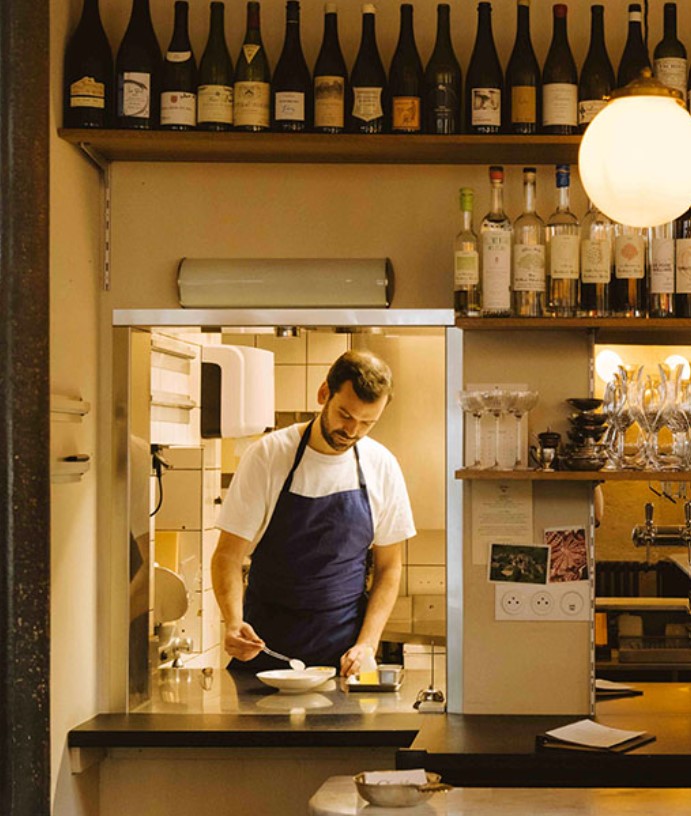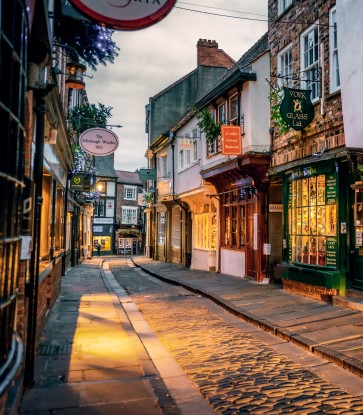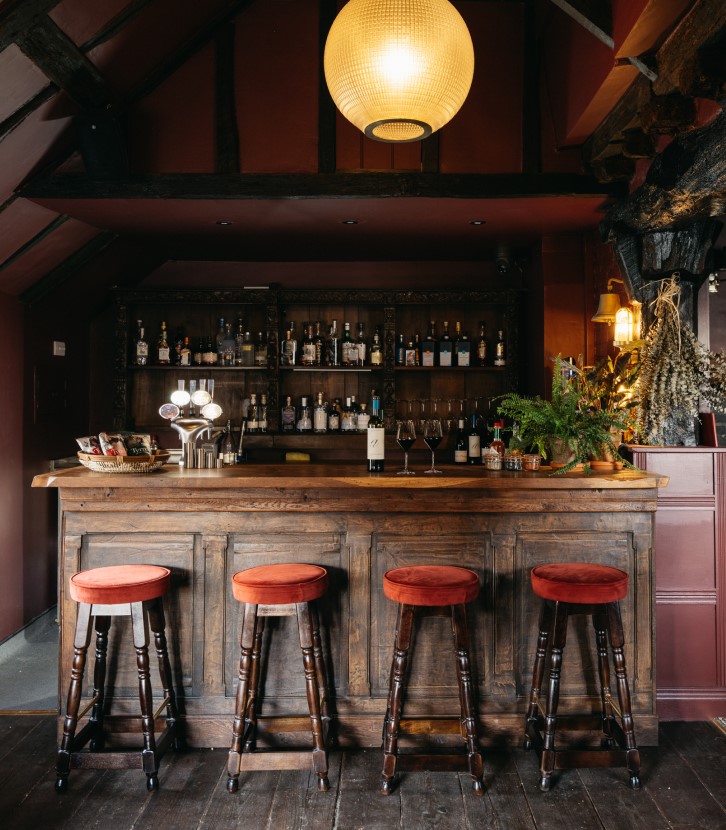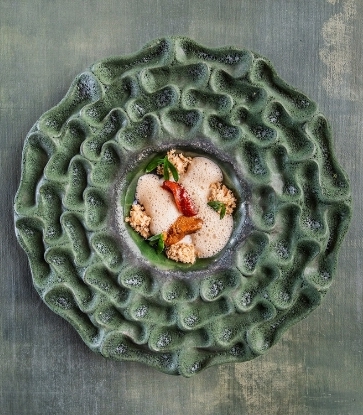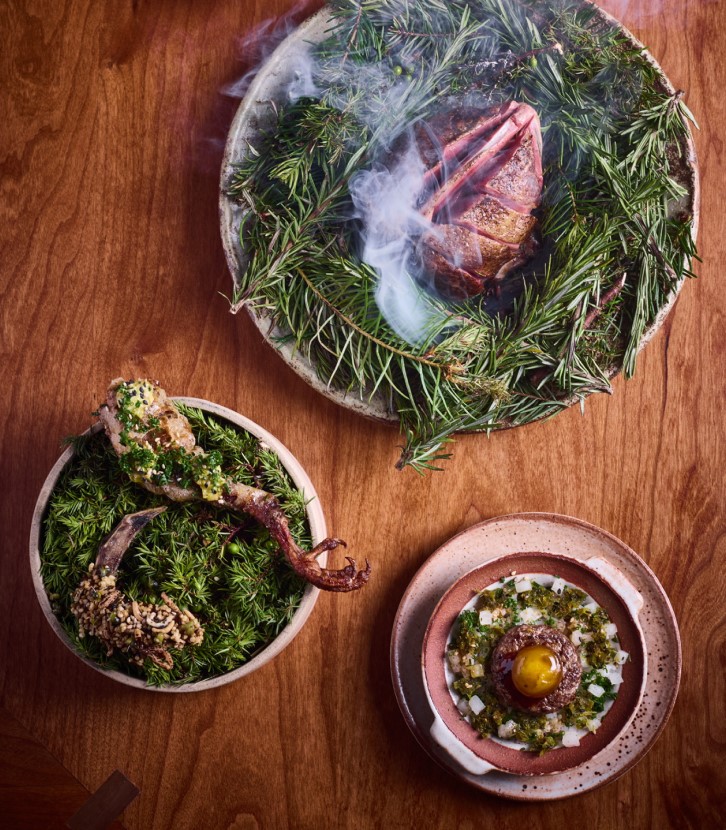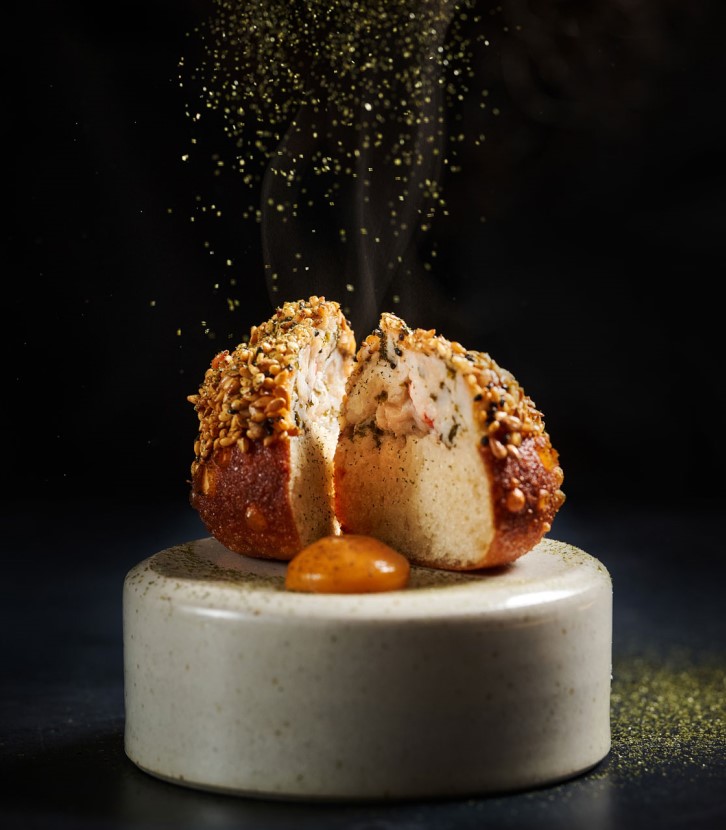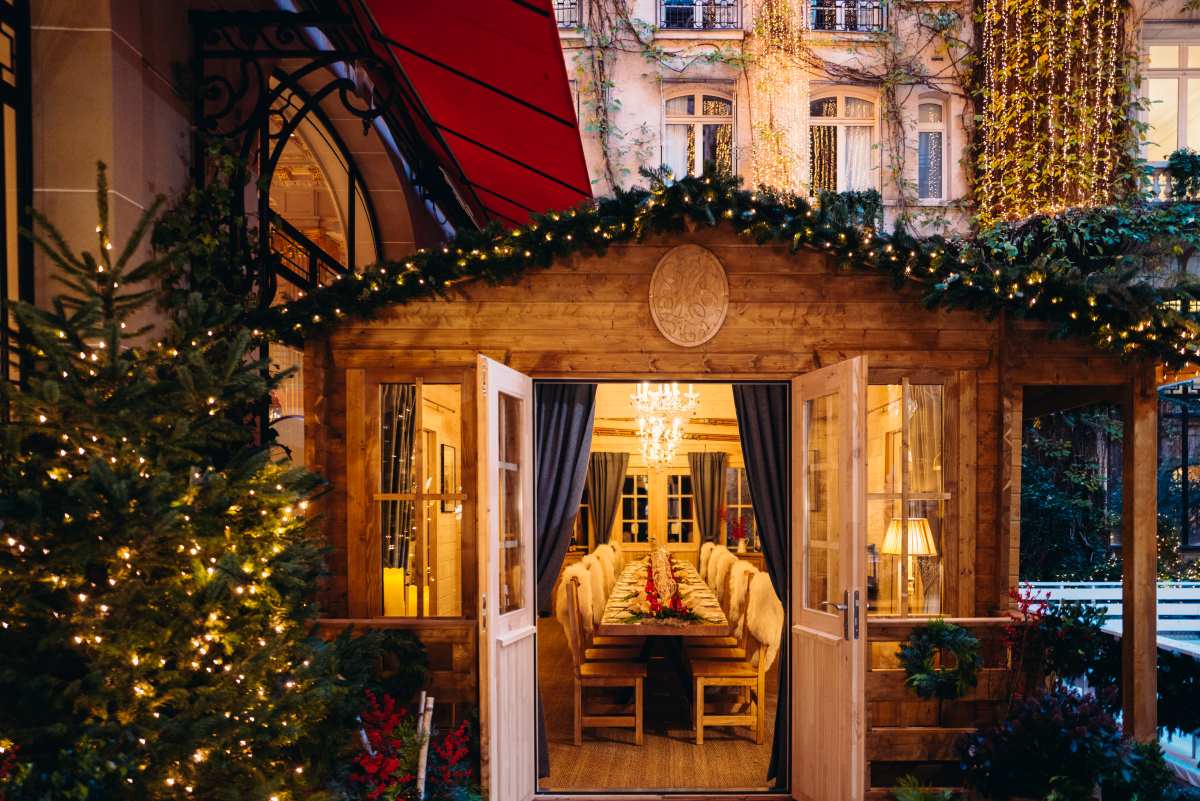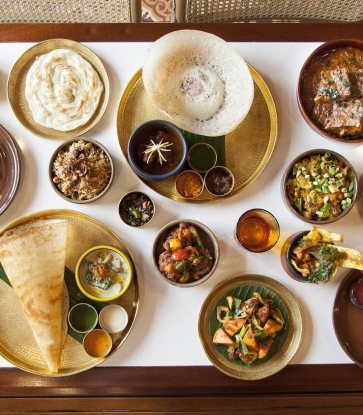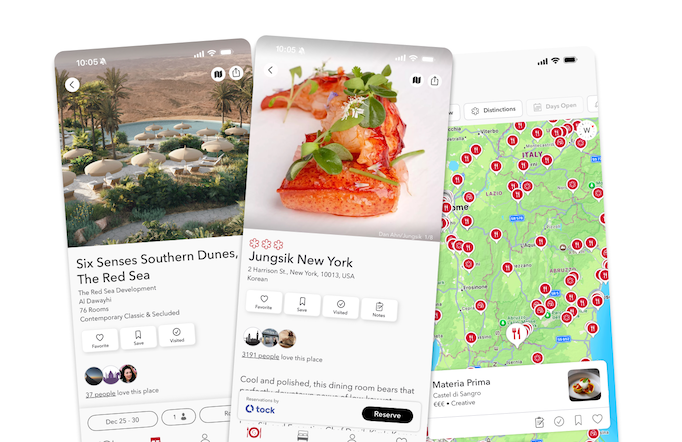Le Coquillage, on Brittany's northern coastline, is a rare gem, and a restaurant that is a true pleasure to dine in, where Chef Hugo Roellinger and his team showcase the fruits of the sea through remarkable dishes with dreamlike names and superlative designs. Following in the footsteps of his father, Olivier Roellinger, Hugo showed throughout my meal that he has an exceptional understanding of spices, and uses them to enhance his produce with real expertise.

Making an Entrance
The approach to Le Coquillage, a little outside Cancale, is a delight in itself. As you follow a path through the woodland, you feel as if you're venturing onto a private property, its grounds planted with trees and flowers. Finally, you come face to face with an unspoiled manor house overlooking the moor, and wonder if you've stumbled into the landscape of an Emily Brontë novel.
The view over the Bay of Mont-Saint-Michel is absolutely incredible, and you feel you are alone in the world: the sea is only a few dozen meters away, and the scent of sea spray lingers in the early evening air.
I'm greeted with a smile by Marine Roellinger, as I continue to take in the interior of this 1920s mansion. In front of me is a succession of small salons with an intimate, inviting feel. The wood paneling oozes quality, the antique hardwood floors add character, and that enchanting view is never far away thanks to bow windows that fit in perfectly with the feel of the place. This view I decide to immortalize before anything else, and the service team even offer to take a photo with me in it. I'm left to enjoy this idyllic setting before night falls, and the peace and quiet is pure bliss.
I'm shown to my table and notice the highly original table setting, which is also utterly in tune with the location. The plate is made of clay extracted from the beach, the crumber is a razor clam shell, the crumbs are collected in an oyster shell. The sea is omnipresent at Le Coquillage, without even a hint of kitsch to the effect. I'm told that the entire meal can be eaten with tongs, which may confuse some, but I'm ready to get on board and navigate Hugo Roellinger's unique culinary universe.

The Understated Charm of a Brilliant Team
In the restaurant, you can feel the energy of the passionate and sincere young team, as well as their determination to convey the chef's culinary vision. The dishes are clearly explained and elucidated, but humbly, without pomp and ceremony. Just like the chef, the service is discreet but attentive. I also feel confident in my choice of wines, thanks to sommelier Gaylord Goulette. Later, maître d' Valentine Roy will serve me the cheese course with particular finesse; the cheeses are presented lovingly, laid out like a work of art on the plate.

Dishes From Your Dreams
A single set menu is served to all diners, "Au gré du vent et de la lune" ("By the whims of the wind and the moon"), comprising 12 courses, so I knew we were in for quite a ride! The delivery of the courses is perfectly executed, both in terms of time management and portion sizes. There is just the right amount of food at every stage, even if it was so good I always wanted one more bite!
While on this culinary odyssey, I noticed that the design of each plate and dish was different, the visuals of every one compelling in its own way, and that there was an invigorating variety to the menu, right down to the different serving temperatures. Every course was a source of wonder and, frankly, you find yourself wishing this meal would never end.
Many of the dishes that evening left an indelible impression on me, and I remember it as a wonderful voyage, rife with sensations, aromas, and sensibility. Hugo Roellinger proposes a deeply personal brand of cuisine that is uniquely his own.
Chemin des Douaniers
Taking its name from the legendary coastal path along Breton shores, this early dish in the menu used the produce of the route as its basis. Spider crab was marinated in elderberry vinegar and combined with a blend of wild herbs, then worked into pieces of varying thickness and crumbs. At the center was an egg yolk; slowly cooked in cider vinegar for 20 minutes and candied, it was properly runny. The server covered it with a richly flavored sauce of spider crab roe and seasonal herbs. I basked in the smell of the fresh, nuanced herbal bouquet of wild fennel, elderberry, and pine needle.
Bois de Cassis
This outstanding dish was built around a scallop that I could see immediately was of superb quality and freshness, offering the promise of fine, silky-smooth notes to come. It was covered in a delicate brown rose and buckwheat jelly, with seaweed sheet shavings. A fragrant porcini and beurre noisette syrup added to the irresistible ensemble. Upon tasting, the Aquitaine caviar, aged for six months, rolled pleasantly over my tongue, subtly competing with the blackcurrant aroma discernibly infused into both the pepper and the oil.

The Signature Dish: Histoires de Homard
Next up was the chef's signature dish, and what a dish! Breton blue lobster was served two ways. Inside a cabbage leaf steamed with cocoa nibs (from cocoa beans that have been roasted before shelling for a particularly intense flavor), I found the lobster meat. It was perfectly cooked, pearlescent and firm, laid on a fruity, robust condiment of dried tomato and mango. The accompanying sauce had a striking personality, blending cocoa, sherry, and exactly the right amount of sweet Mexican chili.
After this first part, I was excited to taste the lobster claws, which were cooked over a wood fire and incorporated into a stew with trout roe. The sauce was remarkably complex and, above all, a perfect fit: a creamy combination of powdered lacto-fermented black pepper, dried piquillo, and West African spice blend. On the palate, I could detect cloves, paradise seeds, cumin, and chili pepper. This course provided impressive depth; it was at once spicy, smoky, and briny, and it was delivered with a delicate and precise touch.
A Final Flourish: Laminaria Digitata
To my great delight, the desserts did not let the side down, the chef having cleverly infused them with his personal stamp: that of a Saint-Malo native, a master of spices, a poet, and a traveler. One of the desserts was a Coquillage classic. In a scallop shell, I found an oarweed (laminaria digitata) ice cream, topped with shredded, one-year-old dried scallops, pearls of month-aged Aquitaine caviar, and strips of candied kombu seaweed.
At the bottom of the shell, I was surprised to discover hazelnut miso powder, for a hit of umami. On paper, it reads like an unexpected combination, and yet with a smoky caramel melting the ice cream, the creamy tastes mingling with the salty, briny notes, the harmony was pitch-perfect. With this dessert, Hugo Roellinger combined audacity with elegance.
A Culinary Signature
While many people will think back to Hugo Roellinger's father, Olivier, who has undoubtedly passed on a remarkably balanced use of spices to his son, the key impression I was left with upon visiting Le Coquillage was that Hugo Roellinger has forged a truly original culinary identity for himself. It is one built on great respect for his environment and his team, and a modesty that sets him apart from most chefs.The chef and his crew go beyond simply delighting their guests; they reach out to take their hand, inviting them on an unforgettable and ever-evolving gastronomic voyage that is marked by moments of pure genius. Each dish gave me the feeling of turning the pages of an explorer's notebook, packed with journeys, scents, and flavors.

Tips From an Inspector
Le Coquillage is not a classic restaurant. Its beating heart is the personality of Hugo Roellinger, whose sensibility and vision pervade the premises. The names of the dishes may be abstract, but this is cooking that doesn't call on the intellect to be appreciated; rather, it speaks to the senses and is immediately accessible, without showmanship. The apparent simplicity conceals a real subtlety in the harmonies of flavors.
The stunning view over the Bay of Mont-Saint-Michel is a big part of the charm, so don't hesitate to ask for a table by the bow window to enjoy it to the full.
Finally, should you wish to extend your time here, Château Richeux (Two MICHELIN Keys) will welcome you. Le Coquillage and the Château are both part of Maisons de Bricourt. This understated and charming hotel with just 13 guestrooms overlooks the bay, affording a view of the untamed beauty of the region.




